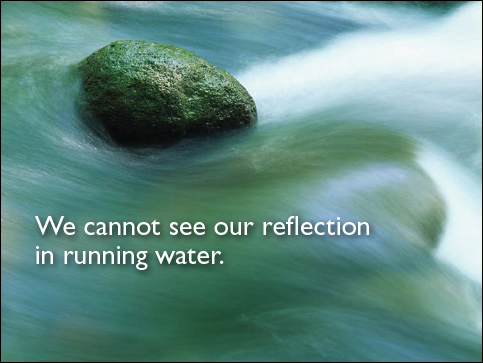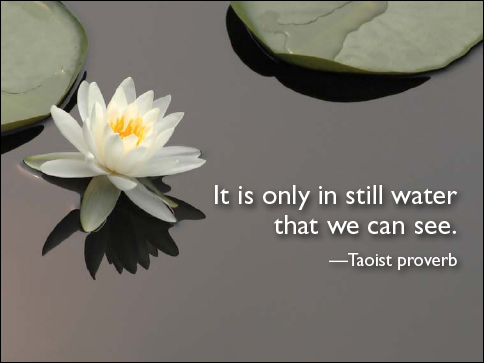Presentation Zen: Simple Ideas on Presentation Design and Delivery, 2nd Edition (Ira Katz's Library) (9 page)
Authors: Garr Reynolds



(Image in slides on these two pages from iStockphoto.com.)
In order to be open to creativity, one must have the capacity for constructive use of solitude. One must overcome the fear of being alone.
—Rollo May
It is said that Buddha described the human condition as much like that of a man who has been shot with an arrow. The situation is both painful and urgent. But let’s imagine that instead of asking for immediate medical assistance for his predicament, the man asks for details about the bow that shot the arrow. He asks about the manufacturer of the arrow. He wonders about the background of the people who made the bow and arrow, how they arrived at the color choice, what kind of string they used, and so on. The man asks many inconsequential questions, overlooking the immediate problem.
Our lives are a bit like this. We often do not see the reality right in front of us because we chase ephemeral things such as larger salaries, the perfect job, a bigger house, more status, etc., and we worry about losing what we have. The Buddhist would say life is filled with dukkha (suffering, pain, loss, a feeling of dissatisfaction)—we need only to open our eyes to see this. In a similar way, the current state of business and academic presentation brings about a fair amount of “suffering” in the form of ineffectiveness, wasted time, and general dissatisfaction, both for the presenter and the audience.
There is much discussion today among professionals on the issue of how to make presentations and presenters better. For them, the situation is both “painful and urgent” in a sense. It’s important. Yet much of the discussion focuses on software applications and techniques. What application should I get? Should I get a Mac or a PC? What animations and transitions are best? What is the best remote control? This is not completely inconsequential, but it often dominates discussions on presentation effectiveness. The focus on technique and software often distracts us from what we should be examining. Many of us spend too much time fidgeting with and worrying about bullets and images on slides during the preparation stage instead of thinking about how to craft the story that is the most effective, memorable, and appropriate for our audience.
In obsessing on technique and tricks and effects, we are a bit like the man who has an arrow stuck in him: Our situation is urgent and painful, yet we are asking the wrong questions and focusing on that which is relatively inconsequential.
Two of the more inconsequential questions I get—and I get these a lot—are “How many bullets should I use per slide?” and “How many slides per presentation is good?” My answer? “It depends on a great many things... how about zero?” This gets people’s attention, but it’s not the most popular answer. I’ll deal with the bullet points question in the chapter on slide design (
Chapter 6
). As for how many slides are best, that really is the wrong question. There are too many variables involved to make a concrete rule. I have seen long, dull presentations from presenters who used only five slides and content-rich, engaging presentations from presenters who used more than 200 slides (and vice versa). The number of slides is not the point. If your presentation is successful, the audience will have no idea how many slides you used, nor will they care.

OK, so you’re alone. You’ve got a pad and a pen. You’re relaxed, and your mind is still. Now imagine that presentation you get to give (notice I did not say “have to give”) next month...or next week or (gulp!) tomorrow. Jot down the answers to these questions:
• How much time do I have?
• What’s the venue like?
• What time of the day will I be speaking?
• Who is the audience?
• What is their background?
• What do they expect of me?
• Why was I asked to speak?
• What do I want them to do?
• What visual medium is most appropriate for this particular situation and audience?
• What is the fundamental purpose of my talk?
• What’s the story here?
• And this is the most fundamental question of all, stripped down to its essence:

Or put it this way: If the audience will remember only one thing (and you’ll be lucky if they do), what do you want it to be?
A lot of the presentations I attend feature a person from a specialized field giving a talk—usually with the help of multimedia—to an audience of business people who are not specialists in the presenter’s technical field.
This is a common presentation situation. For example, an expert in the area of biofuel technology may be invited to give a presentation to a local chamber of commerce about the topic and about what his company does. Recently, I attended such an event, and after the hour-long talk was over, I realized the presentation was a miracle of sorts: until that day I didn’t think it was possible to listen to someone make a presentation with slides in my native language of English and still not understand a single point that was made. Not one.
Nada
. I wanted my hour back.
The wasted hour was not the fault of the software or bad slides, however. The presentation would have been greatly improved if the presenter had simply kept two questions in mind while preparing for the talk: What is my point? And why does it matter?
It’s hard enough for presenters to find their core message and express it in a way that is unambiguously understood. But why does it matter? This is where people really stumble. Often, the presenter is so close to his material that the question of why it should matter simply seems too obvious to make explicit. Yet that is what people (including most audiences) are hoping you’ll tell them. “Why should we care?” That’s going to take persuasion, emotion, and empathy in addition to logical argument. Empathy comes into play in the sense that the presenter must understand not everyone will see what to him is obvious, and others may understand well but not see why it should matter to them. When preparing material for a talk, good presenters try to put themselves in the shoes of their audience members.
To get back to my wasted hour, the presenter, who was smart, accomplished, and professional, failed before he even started. The slides looked as if they were the same ones used in previous presentations to more technical audiences, an indication that he had not thought first and foremost about his audience that day. He failed to answer the important question: “Why does it matter?” In the preparation stage, he also failed to remember that presentation opportunities such as this one are about leaving something important behind for the audience.

(So What?)
In Japanese, I often say to myself, “
Dakara nani
?” or “
Sore de...
?” which translates roughly as “So what?” or “Your point being...?” I say this often while I am preparing or helping others prepare their material.
When building the content of your presentation, you should always put yourself in the shoes of the audience and ask, “So what?” Really ask yourself the tough questions throughout the planning process. For example, is your point relevant? It may be cool, but is it important to further your story, or is it included only because it seems impressive to you? Surely you have been in an audience and wondered how the presenter’s information was relevant or supported his core point. If you can’t answer that question, then cut that bit of content out of your talk.
If
Dakara nani
does not work for you, then check the clarity of your presentation’s core message with the elevator test. This exercise forces you to “sell” your message in 30–45 seconds. Imagine this situation: You are scheduled to pitch a new idea to the head of product marketing at your company, one of the leading technology manufacturers in the world. Both schedules and budgets are tight; this is an extremely important opportunity if you succeed in getting the OK from the executive team. When you arrive at the admin desk outside the vice president’s office, she comes out with her coat and briefcase in hand and says, “Sorry, something’s come up. Give me your idea as we walk down to my car.” Could you sell your idea in the elevator ride and the walk to the parking lot? Sure, the scenario is unlikely, but it’s possible. What is more likely, however, is for you to be asked to shorten your talk down from, say, 20 minutes to 5 minutes or from a scheduled hour to 30 minutes on short notice. Could you do it? You may never have to, but practicing what you would do in such a case forces you to get your message down and make your overall content tighter and clearer.

